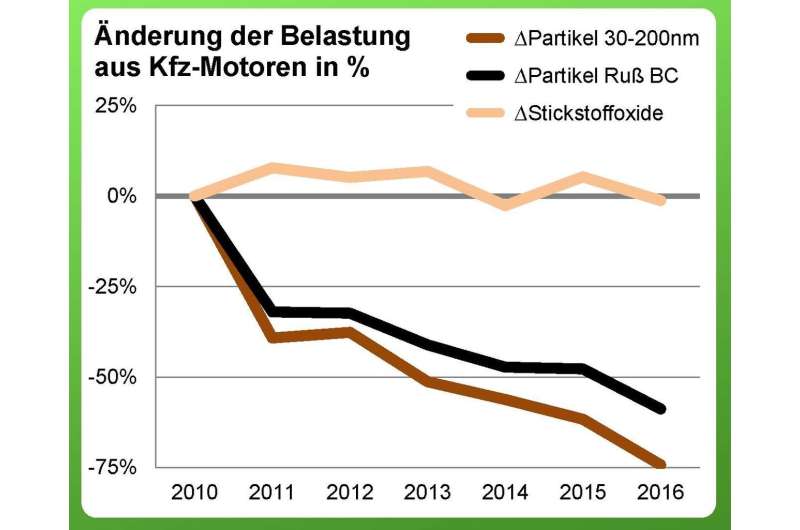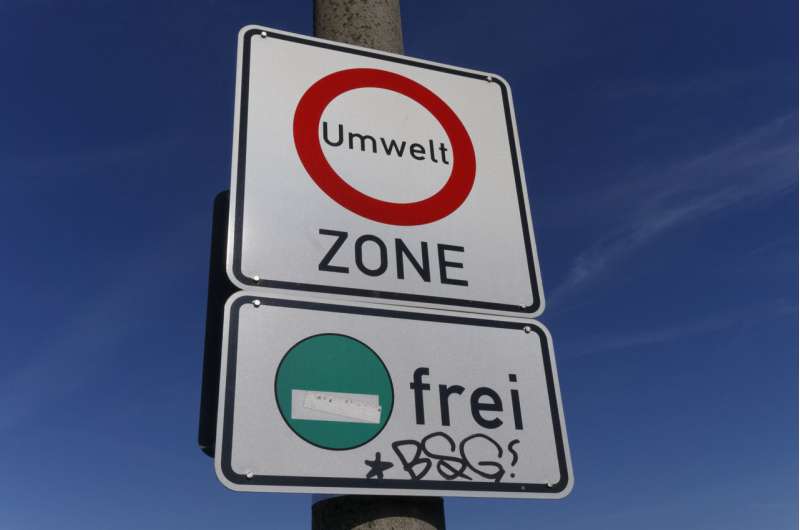Healthier air due to the low emission zone

The low emission zone in Leipzig was established in March 2011, allowing only diesel vehicles of Euro4 and higher with few exceptions. The ban of older vehicles and subsequent modernization of the car fleet resulted in slightly reduced PM10 and PM2.5 mass concentrations. However, the mass concentration of black carbon (soot particles) emitted mainly from diesel vehicles decreased by 60 percent at the street site.
These particles are believed to be most dangerous due to their carcinogenic trace compounds such as polycyclic aromatic hydrocarbons. Furthermore, the number concentration of ultrafine particles, which can penetrate deep into the lungs, also decreased by approximately 70 percent. Despite modernized diesel vehicles, nitrogen oxide concentrations did not follow these trends, and remained nearly constant. The main achievement of the low emission zone was the improvement of air quality by the reduction of the most dangerous particles.
The findings are part of a joint scientific study by the Saxon State Office of the Environment, Agriculture and Geology (LfULG) and the Leibniz Institute for Tropospheric Research (TROPOS).
From the beginning, the city of Leipzig implemented the low emission zone at the highest regulatory level. Only vehicles with green emission stickers have been allowed to enter the zone. Leipzig's low emission zone covered approximately two thirds of the total city area. At the time of implementation, the city of Leipzig was under heavy criticism, mainly from small and mid-sized enterprises, which were put under pressure to renew their fleet of light duty vehicles to a modern standard. The city of Leipzig received the final report, "Effect of the low emission zone on Air Quality," from the Saxon State Office for the Environment (LfULG) and the Leibniz Institute for Tropospheric Research (TROPOS).
The final conclusion of the report was very positive. Scientists from both institutes complimented the regular air quality observations with additional measurements, and they investigated changes over a period of seven years. Thirteen monitoring stations in Saxony provided data. In seven of these 13 stations, black carbon and ultrafine particles have been additionally measured, though these particle measurements are not prescribed by law.

In order to evaluate the assessment of the low emission zone, the scientists determined the reduction of tailpipe emissions of black carbon and ultrafine particles at a street site by taking into account the concentrations measured in the urban background. The reduction in black carbon and ultrafine particles was most significant at the measuring station Leipzig Mitte (Leipzig Central). This is the measuring station at the congested inner city ring road. There, the mass concentration of carcinogenic soot particles dropped by approximately 60 percent and the number concentration of ultrafine particles by ~70 percent.
"This has significantly reduced the toxic composition of particulate matter," said Professor Alfred Wiedensohler from TROPOS. "In terms of the PM mass concentration, this reduction corresponds only to about 5 percent. Since these particles are however part of the highly toxic fraction of fine particulate matter, the health risk of the population was significantly reduced. The low emission zone was thus a meaningful and successful measure of the city administration of Leipzig to protection of the health of their citizens," said air quality expert Gunter Löschau from the LfULG.
City representative Heiko Rosenthal also drew a positive conclusion: "The implementation of the low emission zone in Leipzig was in line with our legal responsibility and a consistent step to achieve a significant improvement in terms of health for the citizens and visitors of the city," said Rosenthal, who serves as mayor of environment, order, and sports of the city of Leipzig.
From the outset, the low emission zone of Leipzig only allowed vehicles in the city with a green sticker, which significantly accelerated the fleet modernization and thus very quickly reduced the particulate emissions of the vehicles. "In doing so, we have succeeded in cushioning the necessary balance between being affected by the ban of vehicles on one the hand, by exemptions on the other hand, but also not losing sight of the actual objective of the low emission zone," Rosenthal continued.
The modernization of the vehicle fleet accelerated the effect of the low emission zone. The proportion of diesel vehicles registered in Leipzig, however, rose from 19 to 26 percent between 2010 and 2016, with negative consequences: While black carbon and the number concentration of ultrafine particles decreased, the concentration of gaseous nitrogen oxides (NOx) is stagnant, and is still too high.
The scientists stressed that further efforts are required to improve the air quality in terms of protecting the population. This applies not only to the exceeding of the limit value for nitrogen dioxide (NO2), but also for particulate matter. The legal limit for particulate matter (PM10) has been met since 2015, including not only the measures for air pollution, but also the meteorological conditions with mild winters would have an influence.
More information: Gunter Löschau, Alfred Wiedensohler, Wolfram Birmili, Fabian Rasch, Gerald Spindler, Konrad Müller, Andrea Hausmann, Uwe Wolf, Werner Sommer, Mario Anhalt, Volker Dietz, Hartmut Herrmann, Uwe Böhme, Horst-Günter Kath und Holm Kühne (2017): Umweltzone Leipzig – Abschlussbericht. lsnq.de/UZLeipzigAbschluss
Provided by Leibniz Institute for Tropospheric Research



















